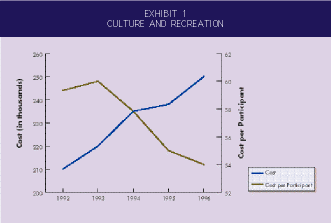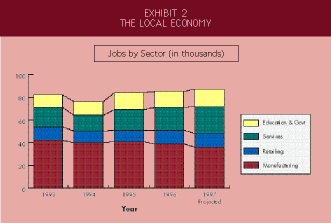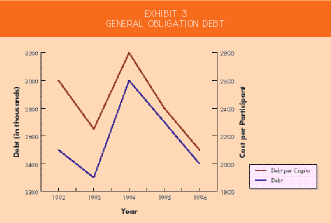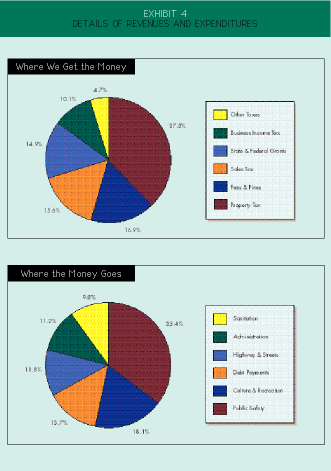|
Making government financial reports suitable for public consumption
Popular
Financial Reports
for Citizens
Hand a copy of your city's audited Comprehensive Annual Financial Report (CAFR) to a local citizen and see what response you get--perhaps laughter or confusion. Why? They find the CAFR overwhelming and unreadable.
In response to this problem, many cities, counties, and special districts try to reach citizens with financial reports designed specifically for their use, from abbreviated financial statements to brochures and calendars. The idea of popular reporting has captured the attention of professional organizations and standard-setters. The Government Finance Officers Association (GFOA) sponsors a Popular Reporting Award Program and the Governmental Accounting Standards Board (GASB) published the research report, Popular Reporting: Local Government Financial Reports to the Citizenry.
Popular reporting offers a service opportunity to CPAs. Elected officials and professional managers often welcome a document that will help them talk to citizens about local government finances. CPAs have served as advisors. Some have initiated the popular reporting idea in various localities, and in certain instances, they have issued accompanying letters.
Although popular reporting is an interesting idea, it is not easy. CPAs are well-qualified to interpret financial information, but their involvement with financial reports designed exclusively for citizens has been limited. When it comes to popular reports, CPAs and government accountants are often forced to rely on their experience with comprehensive reporting for sophisticated users. Beyond that, popular reporting is largely a matter of trial and error.
Based on a review of existing reports, interviewing preparers, studying communication methods, and developing a model report, the following paragraphs contain a framework for preparing popular reports.
Establish a Citizen's Perspective
The feature that sets apart a popular report from all other external reports is the lack of rules. There are no rules dictating a report's content, format, or manner of presentation. The measure of success is whether the citizens get the message. To make that happen, preparers need to give serious attention to the concerns of the citizens and to the message local officials want to deliver.
Know Your Audience. Experience with the CAFR has proven that one report can't satisfy everyone. If the success of a popular report is measured by whether the message reaches the citizens, the obvious starting point is to tailor the report to their needs. A condensed report prepared with bond rating agencies in mind will probably completely miss the mark.
In choosing the appropriate report format, depth of coverage, and complexity of presentation, preparers need to consider the citizens' education, interests, and involvement in local government. The complexity of the presentation should depend on the sophistication of the readers, not the preparers. Current public opinion is a factor to be considered. If there is controversy over the cost or quality of city services, it should be discussed in the report.
Narrow Your Objectives. In order to communicate with citizens, preparers should start with a few clearly stated report objectives. They will provide the rationale for choosing among many options the report might address. It also improves the likelihood that the audience will understand the message.
A popular report, for example, should give citizens a view of city operations and financial position that they cannot get from other sources. Ideally, it would provide an overall view of the city's finances. Realistically, however, this may represent a high hurdle for the audience. A more reasonable goal for initial attempts at popular reporting would be to explain only a few significant aspects of city finances. The cost of general city services and an analysis of revenue mix and resource needs are often reported. An even more focused view may be appropriate when specific problems dominate the city scene.
Focus on Analysis, Not Disclosure
Citizens probably have some of the same concerns as experienced users. An experienced user relies on an analysis of comparative data and an understanding of the environment to assess financial health and project future operating and resource needs. Citizens must rely on administrators and preparers to analyze and explain financial data. They are likely to be interested in three related questions:
1. How did last year turn out?
2. What's new?
3. What is likely to happen in the future?
Attention should be focused on whether plans publicized and approved during budget hearings turned out as expected. In addition to comparing actual results to the original budget, the report should explain how significant variations will affect future planning, operations, and financial position. Nonfinancial measures of service efforts and accomplishments related to expenditures, such as student pass rates on proficiency tests, miles of streets paved, police response times, or usage of recreation facilities are candidates for additional disclosure. These
provide some basis for evaluating the numbers.
Key economic, policy, or program changes will help direct readers to what is new. If the city has chosen to outsource garbage collection, preparers may wish to highlight the changes in cost and service that resulted from the change. Exhibit 1 illustrates increased culture and recreation activities at a lower cost per person. Officials may want to explain the reasons for actions initiated by the city
and the anticipated effects on future
operations.

Citizens' primary interest in historical financial information is its impact on future tax rates and service levels. They may find data from the CAFR, trends projected from those data, and immediate issues facing the government useful information. By starting with a historical perspective and following through to future projections, popular reports can provide a continuous update on finances or economic health. Exhibit 2 is an example of using a graph to portray the job situation in the local economy.

Be Objective
A popular report lacks important elements that contribute to objectivity in the CAFR: full disclosure, precise accounting terminology, and an independent audit. The entire process of preparing a popular report--from choice of topics to the tone of the text--is vulnerable to bias. Many popular reports published by local governments are no more than public relations documents. These may have their place, but they do not provide accountability to the citizens.
CPAs are experts in objectivity. They understand the need for objectivity and can assist in achieving it. The CPA who has audited the CAFR will understand the government's overall financial condition and some messages the government should be communicating. CPAs' experience with management's discussion and analysis in corporate annual reports should also help.
Balance is the key to issuing a reasonably objective report. Local government managers must take seriously their responsibility to provide a forthright view to citizens. A report to citizens may cover successes and favorable trends, but it should include a discussion of problems, as well.
Make the Report User-Friendly
For most people, reading a local government's financial report is neither a job-related nor an investment activity. Preparers must provide incentives to encourage citizens to read the report.
Keep It Short! The discretionary time citizens spend with a popular report is a scarce resource. Considering that, the reports should be short. The CAFR should not be used as a standard of comparison. A popular report should not take more than half an hour to read. The popular report in the GASB monograph on reports to citizens was limited to 15 pages, including several charts and graphs and generous amounts of white space. Many effective reports are much shorter. The reader who wants more can always be referred to the CAFR.
Use Journalistic Writing Style. The popular report most likely to get the
message across requires not only minimum reader time, but minimum mental effort. To judge an appropriate writing style, preparers should refer to the publication common to all citizens, the local newspaper. Journalistic writing style includes short sentences, paragraphs, and sections; familiar words; and liberal use of headings.
Converting to a simple writing style is not easy for preparers who think in technical accounting language. Terms such as intergovernmental revenues and operating transfers are part of a government accountant's working vocabulary, but they will confuse citizens. Accountants and administrators may need editorial help. One approach is to ask nontechnical people to read the report. Another is to use computer software packages to rate the readability of text and help convert technical writing to a simpler style. Finally, if potentially confusing terms, such as infrastructure and deferred revenues can't be avoided, their meaning should be explained.
Use Pictures, Graphs, and Tables. Photographs and drawings appeal to readers and reinforce the topics being discussed. Illustrations of capital improvements give meaning to a discussion of construction costs. Photographs effectively direct attention to damage and deterioration.
Graphics are useful for showing comparative data in minimum space. Graphs and charts can be used effectively to reinforce, expand, or even replace narrative presentation. Computer graphics programs make the job relatively easy.
As few as three colors used throughout a report can lighten the tone and create visual interest. Since printing costs increase with the addition of color, the decision to use color should be made early.
Vary the Layout. Good layout will encourage readers to keep reading. Good design does not cram as many numbers and as much text as possible into a few pages. The use of headings with a combination of text, illustrations, and tables can visually cut each topic into short, easy-to-read bites.
Some local governments have used a calendar layout, encouraging users to leave one page open for a month. This style, with repeated exposure, may warrant more detail than other reports.
Simplify the Financial Statements. Many reports end with a full set of general purpose financial statements. This is guaranteed to cause most readers to
stop reading. A better way is to start
with a plan to include only financial statement information that contributes
significantly to the objective. Then it should be presented in a manner that
is easy for citizens to understand.
Exhibit 3 shows two important aspects of a city's debt.

The operating statement might be broken into a few simple tables or graphics. Details of expenditures can be presented near a discussion of city services, while revenue details are presented elsewhere. Both are illustrated in pie charts in Exhibit 4. Summary information, such as total revenues and expenditures, can be presented in tabular format or bar charts, to highlight differences.

The AICPA and GFOA suggest footnotes regarding the basis of accounting and reconciliation with CAFR presentation. A user-friendly approach, however, would avoid footnotes in favor of explanation or analysis in context. Most preparers do state that the popular report is not in conformity with GAAP and the report refers users to the CAFR if they are interested.
Get the Report to the Citizens
How should a popular report be delivered? Local officials can use popular reports when they speak to groups such as the Rotary Club or the League of Women Voters. Some cities mail popular reports to all citizens or include them as a newspaper supplement. Reports can be placed in the library and in locations where people routinely have idle time: car washes, laundries, hospital waiting areas, and government offices. The popular report is a natural feature for government or local access television stations. If the government has a home page, it should be there, too.
Publicity may generate interest and encourage citizens to read the report. Comments on the report by media, business, and civic leaders will underscore its significance and can focus attention on accountability. The report itself should be used to request feedback. It may encourage citizens to pay more attention, and the feedback helps preparers improve next year's report. *
Florence C. Sharp, CPA, PhD, is the O'Bleness Professor of Accountancy at Ohio University, Frances H. Carpenter, CPA, PhD, practices accounting in Columbia, S.C., and Robert F. Sharp, CPA, PhD, is an associate professor of accounting at Ohio University.
By Florence C. Sharp, Frances H. Carpenter, and Robert F. Sharp
In Brief
A Picture Is Worth a ...
Many government officials, both elected and professional, welcome a viable means of explaining to the public what a particular government financial report really says. The authors are suggesting a new service opportunity for CPAs--popular reporting, the preparation of interpretive information that local citizens might wish for when trying to interpret government financial reports.
There are no rules for popular reporting, only the goal that an understandable message addressing the concerns of the readers be delivered. In order to accomplish this goal the authors discuss the details of how to establish a citizen's perspective, focus on analysis rather than disclosure, be objective, and make the report user friendly. They also make it clear that popular reports should just not be a public relations document, but should provide accountability to the citizens reading them.
The CPA Journal is broadly
recognized as an outstanding, technical-refereed publication aimed at public
practitioners, management, educators, and other accounting professionals.
It is edited by CPAs for CPAs. Our goal is to provide CPAs and other accounting
professionals with the information and news to enable them to be successful
accountants, managers, and executives in today's practice environments.
©2009
The New York State Society of CPAs. Legal
Notices
| 




